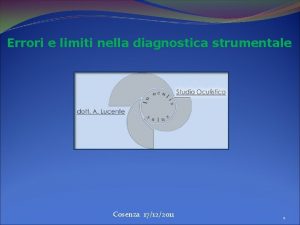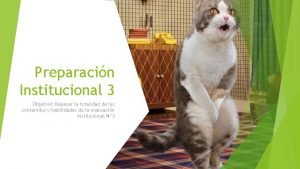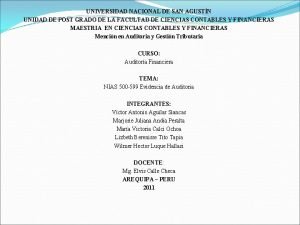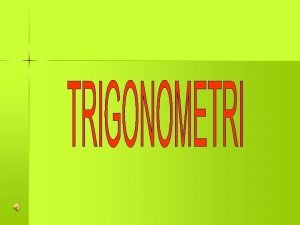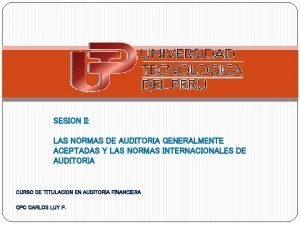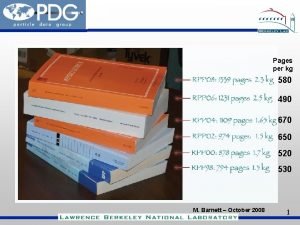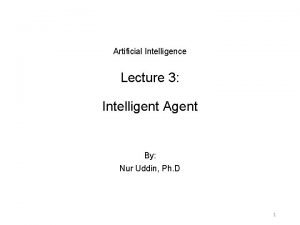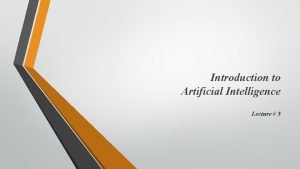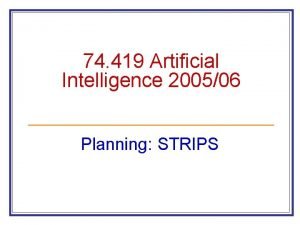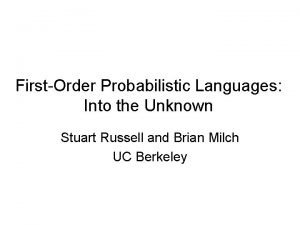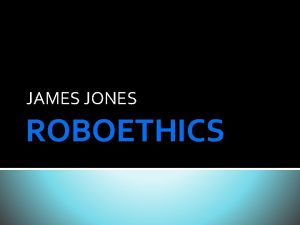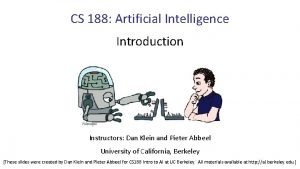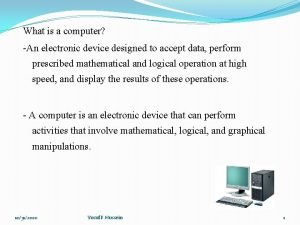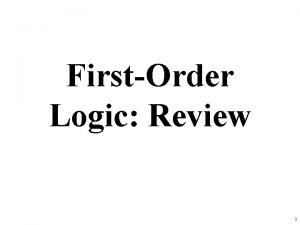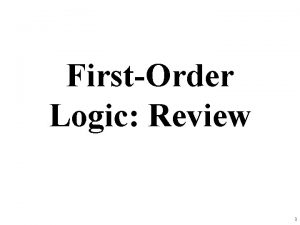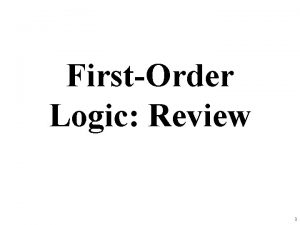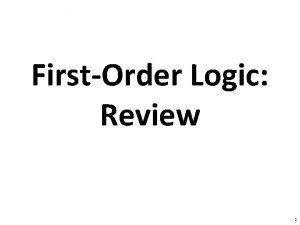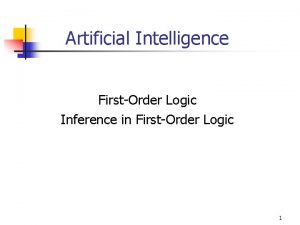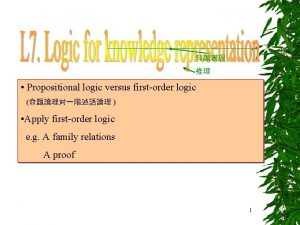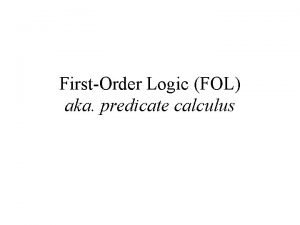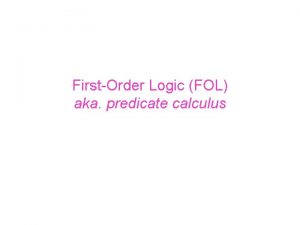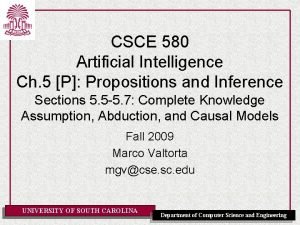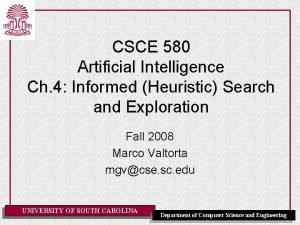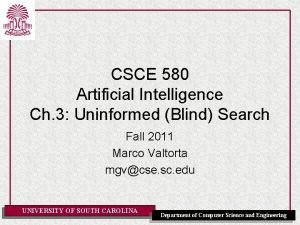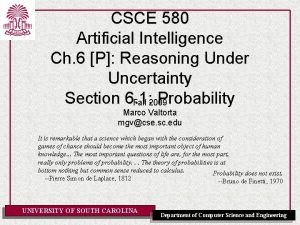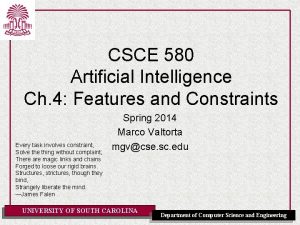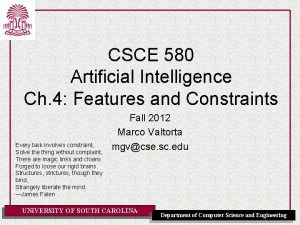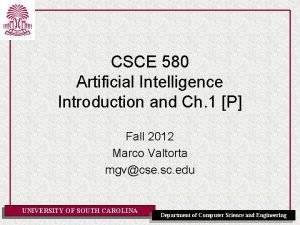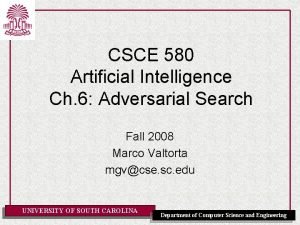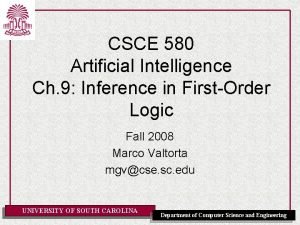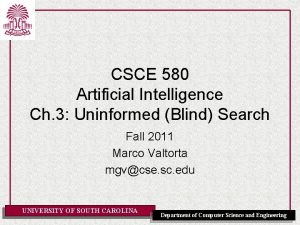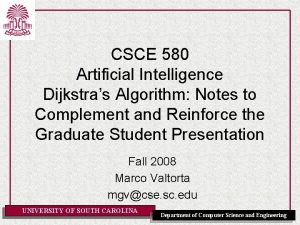CSCE 580 Artificial Intelligence Ch 8 FirstOrder Logic

![Acknowledgment • The slides are based on the textbook [AIMA] and other sources, including Acknowledgment • The slides are based on the textbook [AIMA] and other sources, including](https://slidetodoc.com/presentation_image/6c0341b70e476aacaec23189e3d21a8d/image-2.jpg)


















![Deducing hidden properties from percepts • x, y, a, b Adjacent([x, y], [a, b]) Deducing hidden properties from percepts • x, y, a, b Adjacent([x, y], [a, b])](https://slidetodoc.com/presentation_image/6c0341b70e476aacaec23189e3d21a8d/image-21.jpg)







- Slides: 28

CSCE 580 Artificial Intelligence Ch. 8: First-Order Logic Fall 2008 Marco Valtorta mgv@cse. sc. edu UNIVERSITY OF SOUTH CAROLINA Department of Computer Science and Engineering
![Acknowledgment The slides are based on the textbook AIMA and other sources including Acknowledgment • The slides are based on the textbook [AIMA] and other sources, including](https://slidetodoc.com/presentation_image/6c0341b70e476aacaec23189e3d21a8d/image-2.jpg)
Acknowledgment • The slides are based on the textbook [AIMA] and other sources, including other fine textbooks and the accompanying slide sets • The other textbooks I considered are: – David Poole, Alan Mackworth, and Randy Goebel. Computational Intelligence: A Logical Approach. Oxford, 1998 • A second edition (by Poole and Mackworth) is under development. Dr. Poole allowed us to use a draft of it in this course – Ivan Bratko. Prolog Programming for Artificial Intelligence, Third Edition. Addison-Wesley, 2001 • The fourth edition is under development – George F. Luger. Artificial Intelligence: Structures and Strategies for Complex Problem Solving, Sixth Edition. Addison-Welsey, 2009 UNIVERSITY OF SOUTH CAROLINA Department of Computer Science and Engineering

Outline • • • Why FOL? Syntax and semantics of FOL Using FOL Wumpus world in FOL Knowledge engineering in FOL UNIVERSITY OF SOUTH CAROLINA Department of Computer Science and Engineering

Pros and cons of propositional logic Propositional logic is declarative Propositional logic allows partial/disjunctive/negated information – (unlike most data structures and databases) Propositional logic is compositional: – meaning of B 1, 1 P 1, 2 is derived from meaning of B 1, 1 and of P 1, 2 Meaning in propositional logic is context-independent – (unlike natural language, where meaning depends on context) Propositional logic has very limited expressive power – (unlike natural language) – E. g. , cannot say "pits cause breezes in adjacent squares“ • except by writing one sentence for each square UNIVERSITY OF SOUTH CAROLINA Department of Computer Science and Engineering

First-order logic • Whereas propositional logic assumes the world contains facts, • first-order logic (like natural language) assumes the world contains – Objects: people, houses, numbers, colors, baseball games, wars, … – Relations: red, round, prime, brother of, bigger than, part of, comes between, … – Functions: father of, best friend, one more than, plus, … UNIVERSITY OF SOUTH CAROLINA Department of Computer Science and Engineering

Syntax of FOL: Basic elements • • Constants King. John, 2, USC, . . . Predicates Brother, >, . . . Functions Sqrt, Left. Leg. Of, . . . Variablesx, y, a, b, . . . Connectives , , Equality = Quantifiers , UNIVERSITY OF SOUTH CAROLINA Department of Computer Science and Engineering

Atomic sentences Atomic sentence = predicate (term 1, . . . , termn) or term 1 = term 2 Term function (term 1, . . . , termn) or constant or variable = • E. g. , • > (Length(Left. Leg. Of(Richard)), Length(Left. Leg. Of(King. John))) a term • Brother(King. John, Richard. The. Lionheart) an atomic sentence UNIVERSITY OF SOUTH CAROLINA Department of Computer Science and Engineering

Complex sentences • Complex sentences are made from atomic sentences using connectives S, S 1 S 2, E. g. Sibling(King. John, Richard) Sibling(Richard, King. John) >(1, 2) ≤ (1, 2) >(1, 2) UNIVERSITY OF SOUTH CAROLINA Department of Computer Science and Engineering

Truth in first-order logic • Sentences are true with respect to a model and an interpretation • Model contains objects (domain elements) and relations among them • Interpretation specifies referents for constant symbols → objects predicate symbols → relations function symbols → functional relations • An atomic sentence predicate(term 1, . . . , termn) is true iff the objects referred to by term 1, . . . , termn are in the relation referred to by predicate UNIVERSITY OF SOUTH CAROLINA Department of Computer Science and Engineering

Models for FOL: Example UNIVERSITY OF SOUTH CAROLINA Department of Computer Science and Engineering

Universal quantification • <variables> <sentence> Everyone at USC is smart: x At(x, USC) Smart(x) • x P is true in a model m iff P is true with x being each possible object in the model • Roughly speaking, equivalent to the conjunction of instantiations of P . . . At(King. John, USC) Smart(King. John) At(Richard, USC) Smart(Richard) At(USC, USC) Smart(USC) UNIVERSITY OF SOUTH CAROLINA Department of Computer Science and Engineering

A common mistake to avoid • Typically, is the main connective with • Common mistake: using as the main connective with : x At(x, USC) Smart(x) means “Everyone is at USC and everyone is smart” UNIVERSITY OF SOUTH CAROLINA Department of Computer Science and Engineering

Existential quantification • <variables> <sentence> • Someone at USC is smart: • x At(x, USC) Smart(x) • x P is true in a model m iff P is true with x being some possible object in the model • Roughly speaking, equivalent to the disjunction of instantiations of P At(King. John, USC) Smart(King. John) At(Richard, USC) Smart(Richard) At(USC, USC) Smart(USC) . . . UNIVERSITY OF SOUTH CAROLINA Department of Computer Science and Engineering

Another common mistake to avoid • Typically, is the main connective with • Common mistake: using as the main connective with : x At(x, USC) Smart(x) is true if there is someone who is not at USC! UNIVERSITY OF SOUTH CAROLINA Department of Computer Science and Engineering

Properties of quantifiers • • x y is the same as y x • • x y is not the same as y x x y Loves(x, y) – “There is a person who loves everyone in the world” y x Loves(x, y) – “Everyone in the world is loved by at least one person” • • Quantifier duality: each can be expressed using the other x Likes(x, Ice. Cream) x Likes(x, Broccoli) UNIVERSITY OF SOUTH CAROLINA Department of Computer Science and Engineering

Equality • term 1 = term 2 is true under a given interpretation if and only if term 1 and term 2 refer to the same object • E. g. , definition of Sibling in terms of Parent: x, y Sibling(x, y) [ (x = y) m, f (m = f) Parent(m, x) Parent(f, x) Parent(m, y) Parent(f, y)] UNIVERSITY OF SOUTH CAROLINA Department of Computer Science and Engineering

Using FOL The kinship domain: • Brothers are siblings x, y Brother(x, y) => Sibling(x, y) • One's mother is one's female parent m, c Mother(c) = m (Female(m) Parent(m, c)) • “Sibling” is symmetric x, y Sibling(x, y) Sibling(y, x) UNIVERSITY OF SOUTH CAROLINA Department of Computer Science and Engineering

Using FOL The set domain: 1. s Set(s) (s = {} ) ( x, s 2 Set(s 2) s = {x|s 2}) 2. x, s {x|s} = {} 3. x, s x s s = {x|s} 4. x, s x s [ y, s 2} (s = {y|s 2} (x = y x s 2))] 5. s 1, s 2 s 1 s 2 ( x x s 1 x s 2) 6. s 1, s 2 (s 1 = s 2) (s 1 s 2 s 1) 7. x, s 1, s 2 x (s 1 s 2) (x s 1 x s 2) 8. x, s 1, s. SOUTH (s 1 s 2) (x s 1 x s 2) 2 x CAROLINA UNIVERSITY OF Department of Computer Science and Engineering

Interacting with FOL KBs • Suppose a wumpus-world agent is using an FOL KB and perceives a smell and a breeze (but no glitter) at t=5: Tell(KB, Percept([Smell, Breeze, None], 5)) Ask(KB, a Best. Action(a, 5)) • I. e. , does the KB entail some best action at t=5? • Answer: Yes, {a/Shoot} • • Given a sentence S and a substitution σ, Sσ denotes the result of plugging σ into S; e. g. , S = Smarter(x, y) σ = {x/Hillary, y/Bill} Sσ = Smarter(Hillary, Bill) ← substitution (binding list) • Ask(KB, S) returns some/all σ such that KB╞ σ UNIVERSITY OF SOUTH CAROLINA Department of Computer Science and Engineering

Knowledge base for the wumpus world • Perception – t, s, b Percept([s, b, Glitter], t) Glitter(t) • Reflex (action) – t Glitter(t) Best. Action(Grab, t) UNIVERSITY OF SOUTH CAROLINA Department of Computer Science and Engineering
![Deducing hidden properties from percepts x y a b Adjacentx y a b Deducing hidden properties from percepts • x, y, a, b Adjacent([x, y], [a, b])](https://slidetodoc.com/presentation_image/6c0341b70e476aacaec23189e3d21a8d/image-21.jpg)
Deducing hidden properties from percepts • x, y, a, b Adjacent([x, y], [a, b]) [a, b] {[x+1, y], [x-1, y], [x, y+1], [x, y-1]} Properties of squares: • s, t At(Agent, s, t) Breeze(t) Breezy(s) Squares are breezy near a pit: – Diagnostic rule---infer cause from effect s Breezy(s) {r} Adjacent(r, s) Pit(r) Also: if a square is not breezy, no adjacent square contains a pit – Causal rule---infer effect from cause r Pit(r) [ s Adjacent(r, s) Breezy(s) ] Also: if all squares adjacent to a given square pitless, the square will not be breezy UNIVERSITY OF SOUTH CAROLINA Department of Computer Science and Engineering

Knowledge engineering in FOL 1. Identify the task 2. Assemble the relevant knowledge 3. Decide on a vocabulary of predicates, functions, and constants 4. Encode general knowledge about the domain 5. Encode a description of the specific problem instance 6. Pose queries to the inference procedure and get answers 7. Debug the knowledge base UNIVERSITY OF SOUTH CAROLINA Department of Computer Science and Engineering

The electronic circuits domain One-bit full adder UNIVERSITY OF SOUTH CAROLINA Department of Computer Science and Engineering

The electronic circuits domain 1. Identify the task – Does the circuit actually add properly? (circuit verification) 2. Assemble the relevant knowledge – Composed of wires and gates; Types of gates (AND, OR, XOR, NOT) – Irrelevant: size, shape, color, cost of gates 3. Decide on a vocabulary – Alternatives: Type(X 1) = XOR Type(X 1, XOR) XOR(X 1) UNIVERSITY OF SOUTH CAROLINA Department of Computer Science and Engineering

The electronic circuits domain 4. Encode general knowledge of the domain – t 1, t 2 Connected(t 1, t 2) Signal(t 1) = Signal(t 2) – t Signal(t) = 1 Signal(t) = 0 – 1≠ 0 – t 1, t 2 Connected(t 1, t 2) Connected(t 2, t 1) – g Type(g) = OR Signal(Out(1, g)) = 1 n Signal(In(n, g)) = 1 – g Type(g) = AND Signal(Out(1, g)) = 0 n Signal(In(n, g)) = 0 – g Type(g) = XOR Signal(Out(1, g)) = 1 Signal(In(1, g)) ≠ Signal(In(2, g)) – g Type(g) = NOT Signal(Out(1, g)) ≠ Signal(In(1, g)) UNIVERSITY OF SOUTH CAROLINA Department of Computer Science and Engineering

The electronic circuits domain 5. Encode the specific problem instance Type(X 1) = XOR Type(X 2) = XOR Type(A 1) = AND Type(A 2) = AND Type(O 1) = OR Connected(Out(1, X 1), In(1, X 2)) Connected(In(1, C 1), In(1, X 1)) Connected(Out(1, X 1), In(2, A 2)) Connected(In(1, C 1), In(1, A 1)) Connected(Out(1, A 2), In(1, O 1)) Connected(In(2, C 1), In(2, X 1)) Connected(Out(1, A 1), In(2, O 1)) Connected(In(2, C 1), In(2, A 1)) Connected(Out(1, X 2), Out(1, C 1)) Connected(In(3, C 1), In(2, X 2)) Connected(Out(1, O UNIVERSITY OF SOUTH CAROLINA 1), Out(2, C 1)) Connected(In(3, C 1), In(1, A 2)) Department of Computer Science and Engineering

The electronic circuits domain 6. Pose queries to the inference procedure What are the possible sets of values of all the terminals for the adder circuit? i 1, i 2, i 3, o 1, o 2 Signal(In(1, C_1)) = i 1 Signal(In(2, C 1)) = i 2 Signal(In(3, C 1)) = i 3 Signal(Out(1, C 1)) = o 1 Signal(Out(2, C 1)) = o 2 7. Debug the knowledge base May have omitted assertions like 1 ≠ 0 UNIVERSITY OF SOUTH CAROLINA Department of Computer Science and Engineering

Summary • First-order logic: – objects and relations are semantic primitives – syntax: constants, functions, predicates, equality, quantifiers • Increased expressive power: sufficient to define wumpus world UNIVERSITY OF SOUTH CAROLINA Department of Computer Science and Engineering
 Inference in first order logic in artificial intelligence
Inference in first order logic in artificial intelligence Isa written representations
Isa written representations Pachimetria 580
Pachimetria 580 Sterling elite 580
Sterling elite 580 El matematico griego pitagoras nacio en el año 580
El matematico griego pitagoras nacio en el año 580 Nia 530 ejemplos prácticos
Nia 530 ejemplos prácticos 0 866 cosinus
0 866 cosinus Nsa 580
Nsa 580 Nia 580
Nia 580 Pdg-670
Pdg-670 Artificial intelligence sop
Artificial intelligence sop Omniscience in artificial intelligence
Omniscience in artificial intelligence Chronological backtracking in depth first search involves
Chronological backtracking in depth first search involves Xoon expert system
Xoon expert system Xkcd artificial intelligence
Xkcd artificial intelligence Searching for solutions in artificial intelligence
Searching for solutions in artificial intelligence Strips planning example
Strips planning example Types of knowledge in artificial intelligence
Types of knowledge in artificial intelligence Conceptual graph in artificial intelligence tutorial
Conceptual graph in artificial intelligence tutorial Artificial intelligence the next digital frontier
Artificial intelligence the next digital frontier Artificial intelligence: a modern approach
Artificial intelligence: a modern approach Ethics of artificial intelligence
Ethics of artificial intelligence Cs188 artificial intelligence
Cs188 artificial intelligence Knowledge manipulation in artificial intelligence
Knowledge manipulation in artificial intelligence Types of artificial intelligencel
Types of artificial intelligencel 8 emerging technologies
8 emerging technologies Informed and uninformed search in artificial intelligence
Informed and uninformed search in artificial intelligence Rule based deduction system in artificial intelligence
Rule based deduction system in artificial intelligence A programmable electronic device designed to accept data
A programmable electronic device designed to accept data


